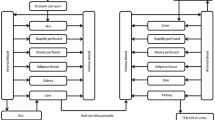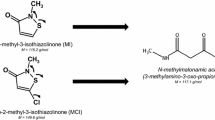Abstract
2,3-Dimercaptopropane-1-sulfonate (DMPS) is a metal chelator approved in Europe for oral or intravenous use for heavy metal poisoning. Transdermally applied DMPS (TD-DMPS) is used by some alternative practitioners to treat autism, despite the absence of evidence for its efficacy. We found no literature evaluating the pharmacokinetics of the transdermal route of delivery or the ability of TD-DMPS to enhance urinary mercury elimination. We hypothesized that TD-DMPS is not absorbed. Eight adult volunteers underwent application of 1.5–3 drops/kg of TD-DMPS. Subjects provided 12-h urine collections the day before and day of application. Subjects underwent blood draws at 0, 30, 60,90, 120, and 240 min after TD-DMPS application. Plasma and urine were assayed for the presence of DMPS. Urine was assayed for any change in urinary mercury excretion after DMPS. One control subject ingested 250 mg of oral DMPS and underwent the same urine and blood collections and analyses. No subject had detectable urine DMPS or increased urine mercury excretion after TD-DMPS. One subject had detectable levels of DMPS in the 30-min plasma sample, suspected to be contamination. All other samples for that subject and the other seven subjects showed no detectable plasma DMPS. The control subject had detectable urine and plasma DMPS levels and increased urine mercury excretion. These results indicate that TD-DMPS is not absorbed. There was no increase in urine mercury excretion after TD-DMPS. Our results argue that TD-DMPS is an ineffective metal chelator.
Similar content being viewed by others
References
Wax PM, Thornton CA (2000) Recovery from severe arsenic-induced peripheral neuropathy with 2,3-dimercapto-1-propanesulphonic acid. J Tox Clin Tox 38(7):777–80
Buttar RA. Buttar Autism Treatment Protocol. http://www.defeatautismyesterday.com/tddmpspro.pdf. Accessed September 10, 2012
Gonzalez MA (2012) http://www.testmyhormones.com/topical_transdermal_dmps_for_autism.htm. Accessed September 10, 2012
Layton R (2012) http://www.allergyconnection.com/autism_dmpsprotocol.html. Accessed September 10, 2012
Alibhai T (2012) http://www.vitaliahealthcare.ca/chelation.html. Accessed September 10, 2012
Koles E (2012) http://www.u-ok.net/chelation_chicago.html. Accessed September 10, 2012
Mitka M (2008) Chelation therapy trials halted. JAMA 300(19):2236
Ruha AM, Curry SC, Gerkin RD, Caldwell KL, Osterlok JD, Wax PM (2009) Urine mercury excretion following meso-dimercaptosuccinic acid challenge in fish eaters. Arch Pathol Lab Med 133(1):87–92
Aposhian HV, Maiorino RM, Gonzalez-Ramirez D et al (1995) Mobilization of heavy metals by newer, therapeutically useful chelating agents. Toxicology 97:23–38
Maiorino RM, Weber GL, Aposhian HV (1986) Fluorometric determination of 2,3-dimercaptopropne-1-sulfonic acid and other dithiols by precolumn derivatization with bromobimane and column liquid chromatography. J Chromatog 374(2):297–310
Maiorino RM, Barry TJ, Aposhian HV (1987) Determination and metabolism of dithiol chelating agents: electrolytic and chemical reduction of oxidized dithiols in urine. Anal Biochem 160(1):217–226
Caldwell KL, Mortensen ME, Jones RL, Caudill S, Osterloh JD (2009) Total blood mercury concentrations in the U.S. population: 1999-2006. Int J Hyg Environ Health 212:588–598
National Center for Environmental Health (2012) The fourth national report on human exposure to environmental chemicals, Department of Health and Human Services, Centers for Disease Control and Prevention, Atlanta, updated February 2012, p 144
Aposhian HV (1998) Mobilization of mercury and arsenic in humans by sodium 2,3-dimercapto-1-propane sulfonate (DMPS). Environ Health Perspect 106(suppl 4):S1017–S1025
Baker JP (2008) Mercury, vaccines, and autism. Am J Public Health 98(2):244–253
Meadows M (2004) IOM report: no link between vaccines and autism. FDA Consum 38(5):18–9
Institute of Medicine (2012) Immunization safety review: vaccine and autism. Institute of Medicine. http://www.iom.edu/Reports/2004/Immunization-Safety-Review-Vaccines-and-Autism.aspx. Accessed on September 10, 2012
Maiorino RM, Dart RC, Carter DE, Aposhian HV (1991) Determination and metabolism of dithiol chelating agents. XII. Metabolism and pharmacokinetics of Sodium 2,3-dimercaptopropane-1-sulfonate in humans. J Pharmacol Exp Ther 259(2):808–814
Hurlbut KM, Maiorino RM, Mayersohm M, Dart RC, Bruce DC, Aposhian HV (1994) Determination and metabolism of dithiol chelating agents XVI: pharmacokinetics of 2,3-dimercapto-1-propanesulfonate after intravenous administration in human volunteers. J Pharmacol Exp Ther 268(2):662–8
Hruby K, Donner A (1987) 2,3-Dimercapto-1-propanesulphonate in heavy metal poisoning. Med Toxicol 2:317–323
Sullivan JB, Krieger GR (2001) Clinical environmental health and toxic exposures, 2nd edn. Lippincott Williams and Wilkins, Philadelphia, p 53
Aposhian HV, Bruce DC, Alter W, Dart RC, Hurlbut KM, Aposhian M (1992) Urinary mercury after administration of 2,3-dimercaptopropoane-1-sulfonic acid: correlation with dental amalgam score. FASEB J 6:2472–2476
Conflict of Interest
The authors have no financial relationships or conflicts of interest relevant to this article to disclose.
Author information
Authors and Affiliations
Corresponding author
Additional information
These data were presented in poster/lecture form at the 2011 North American Congress of Clinical Toxicology. Additionally, an abstract on the methodology of the DMPS assay designed by the FDA-DPS was accepted for presentation at the American Association of Pharmaceutical Scientists Annual Meeting and Exposition in October, 2012.
Rights and permissions
About this article
Cite this article
Cohen, J.P., Ruha, AM., Curry, S.C. et al. Plasma and Urine Dimercaptopropanesulfonate Concentrations after Dermal Application of Transdermal DMPS (TD-DMPS). J. Med. Toxicol. 9, 9–15 (2013). https://doi.org/10.1007/s13181-012-0272-9
Published:
Issue Date:
DOI: https://doi.org/10.1007/s13181-012-0272-9




